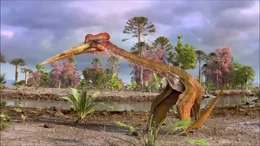| Quetzalcoatlus | |
|---|---|

| |
| An artist's interpretation of Quetzalcoatlus northropi | |
| Scientific classification | |
| Kingdom: | Animalia |
| Phylum: | Chordata |
| Class: | Sauropsida |
| Family: | Azhdarchidae |
| Genus: | †Quetzalcoatlus Lawson, 1975 |
| Type species | |
| †Quetzalcoatlus northropi Lawson, 1975 | |
| Synonyms | |
| |
Quetzalcoatlus (Kwet-sal-co-AT-lus) was a pterodactyloid pterosaur from the Late Cretaceous of North America, and the largest known flying animal to have ever lived. It was a member of the Azhdarchidae, a family of advanced toothless pterosaurs with unusually long, stiffened necks. Even though it is not a dinosaur, It would be amazing to see this creature glide through the sky. It was one of the biggest pterosaurs, alongside Hatzegopteryx.
Description
Head
Skull material from the as of yet unnamed smaller species shows that Quetzalcoatlus had a long sharp beak, with no hook and the end, like a modern stork. This is contrary to earlier skull material, which seemed to have shown an unusually blunt snout. Based on the inadvertent inclusion of jaw material of another pterosaur species, possibly a Tapejara or a form related to Tupuxuara. A skull crest was present, but its exact size and shape are currently unknown.
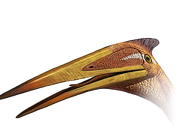
A close-up of the Pterosaur's head and toothless beak.
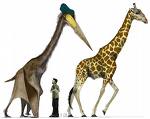
Quetzalcoatlus was the biggest flying creature that ever lived (second biggest if Hatzegopteryx is in fact bigger than Quetzalcoatlus).
Size
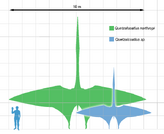
Scale between the two Quetzalcoatlus species and a Human
Quetzalcoatlus northropi is the largest known animal to have ever been able to fly. When it was first discovered, scientists estimated that the fossil came from a pterosaur with a wingspan of up to 45 feet (13.7m), choosing the middle between three extrapolations from the proportions of other pterosaurs that gave an estimate of 40, 50 and 70 feet respectively. in 1981, a further study showed that this estimate was too large, and lowered the estimated wingspan to 50 feet (15m). More recently, the wingspan estimated has been reduced yet again, this time to 36 feet (10.9m).
Mass estimates for giant azhdarchids are extremely problematic because no existing species share a similar size or body plan, and as a result published results vary widely. A 2002 study suggested a body mass of 200–260 kg for Quetzalcoatlus, considerably lower than most other recent estimates.
The issue of the size of Quetzalcoatlus is related to the question of what the upper size limit for an animal flight might be and whether Quetzalcoatlus might have reached it. However, such claims once also accompanied the discovery of large (perhaps up to 30 ft) Pteranodon. The azhdarchid Hatzegopteryx has been estimated to possibly be as big as Quetzalcoatlus, but it’s a really confusing question.
Discovery and Species
The first Quetzalcoatlus fossils were discovered in Texas (from the Maastrichtian Javelina Formation at Big Bend National Park) in 1971 by geology graduate student Douglas A. Lawson. The specimen consisted of a partial wing (made up of the forearms and elongated fourth finger in pterosaurs), from an individual later estimated at over to 10 m (33 ft) in wingspan. Lawson discovered a second site of the same age, about forty kilometers from the first, where between 1972 and 1974 he and Professor Winn Langston Jr. of the Texas Memorial Museum unearthed three fragmentary skeletons of much smaller individuals. Lawson in 1975 announced the find in an article in Science. That same year, in a subsequent letter to the same journal he made the original large specimen, TMM 41450-3, the holotype of a new genus and species, Quetzalcoatlus northropi. The genus name refers to the Aztec "feathered serpent" god Quetzalcoatl. The specific name honors John Knudsen Northrop, the founder of Northrop, who was interested in large tailless aircraft designs resembling Quetzalcoatlus. At first, it was assumed that the smaller specimens were juvenile or sub-adult forms of the larger type. Later, when more remains were found, it was realized they could have been a separate species. This possible second species from Texas was provisionally referred to as a Quetzalcoatlus sp. by Alexander Kellner and Langston in 1996, indicating that its status was too uncertain to give it a full new species name. The smaller specimens are more complete than the Q. northropi holotype, and include four partial skulls, though they are much less massive, with an estimated wingspan of 5.5 meters (18 ft).
An azhdarchid neck vertebra, discovered in 2002 from the Maastrichtian age Hell Creek Formation, may also belong to Quetzalcoatlus. The specimen (BMR P2002.2) was recovered accidentally when it was included in a field jacket prepared to transport part of a tyrannosaur specimen. Despite this association with the remains of a large carnivorous dinosaur, it shows no evidence that it was fed on by the dinosaur. The bone came from an individual azhdarchid pterosaur estimated to have had a wingspan of 5 - 5.5m (16.5 – 18 ft).
In 1995, a partial skeleton of a juvenile azhdarchid was discovered in Dinosaur Provincial Park, probably from Quetzalcoatlus or another closely related animal. The carcass had been scavenged by the small dromaeosaurid Saurornitholestes, which broke off a tooth on one of the wing bones.
Paleobiology
Quetzalcoatlus was abundant in Texas during the Lancia in a fauna dominated by Alamosaurus. The Alamosaurus-Quetzalcoatlus association probably represents semi-arid inland plains. Quetzalcoatlus had precursors in North America and its apparent rise to widespreadness may represent the expansion of its preferred habitat rather than an immigration event, as some experts have suggested.
Feeding
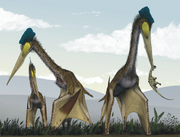
The Ground feeding Hypothesis
The feeding habits of Quetzalcoatlus are controversial. Originally, it was assumed to catch fish and crustaceans, like most other pterosaurs, until it was realized that it lived 248 miles from any shore during the Cretaceous period and that there was no evidence for an inland water source for miles around. Lawson, in 1975, rejected the fish-eating hypothesis and said that it instead was a scavenger it could of soared around waiting for larger predators to go, like a marabou stork, feeding on the carcasses of sauropods and other dead dinosaurs it also may of taken unprotected young dinosaurs as a quick Snack.
In 1996, Thomas Lehman and Langston rejected the scavenging hypothesis, pointing out that the lower jaws bent so strongly downwards that even when they closed completely a gap of over five centimeters remained with the upper jaws, very different from the hooked beaks of specialized scavenging birds. They suggested that with its long neck vertebrae and long toothless jaws Quetzalcoatlus fed like modern-day skimmers, catching fish on the wing while cleaving the waves with its beak. While this skim-feeding view became widely accepted, it was not subjected to scientific research until 2007 when a study showed that for such large pterosaurs it was not a viable method because due to excessive drag the energy costs would be too high. In 2008 pterosaur workers Mark-Paul Witton and Darren Naish published an examination of possible feeding habits and ecology of azhdarchids. Witton and Naish noted that most azhdarchid remains are found in inland deposits far from the seas or other large bodies of water required for skimming. Additionally, the beak, jaw, and neck anatomy are unlike those of any known skimming animal. Rather, they concluded that azhdarchids were more likely terrestrial stalkers, similar to modern storks, and probably hunted small vertebrates on land or in small streams. Though Quetzalcoatlus, like other pterosaurs, was a quadruped when on the ground, Quetzalcoatlus and other azhdarchids have fore and hind limb proportions more similar to modern running ungulate mammals than to their smaller cousins, implying that they were uniquely suited to a terrestrial lifestyle.
Flight
Studies have shown that Quetzalcoatlus could take off under its own power, but once aloft it may have spent much of its time soaring. To test the flight on Quetzalcoatlus, a program sponsored by Johnson Wax involved the construction of a model flying machine. It was about half scale (20 ft), the size of Quetzalcoatlus sp., and had a simple computer functioning as an autopilot. The experiment worked and the model flew through the skies with a combination of soaring and wing flapping. The model is now resting in the Smithsonian Institution Air and Space Museum.
Environment
During the Cretaceous period, Texas' environment was that of a vast swamp. This swamp extended far into North America at this time, following the Western Interior Seaway up into Canada and beyond. Fossils of related pterosaurs can be found in other areas of this prehistoric swamp, in Alberta, Canada.
Being found in layers of rock only slightly older than the K-T event, Quetzalcoatlus most likely became extinct due to this same event.
In Popular Culture

The fictional Skybax of Dinotopia.
- Quetzalcoatlus was the star of the 1986 IMAX movie On the Wing where a half-sized robot version engineered by AeroVironment demonstrated primitive flight.
- It appears in the nature documentary Walking with Dinosaurs episode "Death of a Dynasty", but is one of the most inaccurate creatures in it, mostly because it is an edit of Ornithocheirus. The real one had no teeth, a longer neck, had pycnofibers, it walked more upright on the ground, had a large flat crest, and a longer, thicker beak.
- It appears in Walking with Dinosaurs: The 3D Movie, where it attacked a pack of crabs close to two baby Pachyrhinosaurus, escaped from a forest fire and got eaten by a Gorgosaurus. But the head is too small. In reality, they were much larger than even the torso. The producers changed this for fear of looking ridiculous. The neck is somewhat too short as well. Despite this, it's accurately depicted with pycnofibers, which it had in real life.
- It appears in the third episode of Dinosaur Planet. It lacks pycnofibers and crouched over the ground, unlike the real pterosaur.
- It appears in When Dinosaurs Roamed America in the late Cretaceous segment. It lacks pycnofibers and crouched over the ground, unlike the real pterosaur. “The same model was also seen in Jeff Corwin’s Giant Monsters.
- It appears in the Cretaceous episode of Animal Armageddon. It lacks pycnofibers.
- Quetzalcoatlus is nr. 112 of the Carnivore Threes that can be created in the game Jurassic Park III: Park Builder.
- At a 2013 Star Wars convention in Germany, a short film was shown with Quetzalcoatlus hunting humans at a beach. Quetzalcoatlus was shown in great detail, like its body structure and skin color, and even male and female versions of the animal. The video ended with the Jurassic World logo. The video was part of Iain McCaig's presentation. Frank Marshall confirmed on Twitter that the video was "not a part of the movie." It is being speculated that this footage is actually for a failed Jurassic Park video game that never made it to the marketplace. According to the video description: It was apparently shown to Kathleen Kennedy and Steven Spielberg. Iain McCaig actually said, "it certainly got Steven interested in dinosaurs again...". It lacks pycnofibers and crouched over the ground, unlike the real pterosaur.
- There are a fictional species of Quetzalcoatlus known as Skybax in the Dinotopia series. But it lacks pycnofibers.

Quetzalcoatlus as it appeared in Walking with Dinosaurs
It was illustrated by Bill Watterson in a Sunday strip of Calvin and Hobbes in May 1993.
- Quetzalcoatlus was also featured in a Christmas special The Christmas Dinosaur. Among them was named spot.
- It was also in Dinosaur Train episode 41: The Wing Kings and in episode 42: The Pterosaur Flying Club Show. A Quetzalcoatlus named Quincy was in both episodes; his dad appeared to have a 42-foot wingspan.

Quetzalcoatlus as it appears in Flying Monsters.
- Quetzalcoatlus makes a few appearances in Dinosaur Revolution but is not identified on the show. It lacks pycnofibers.
- Quetzalcoatlus appears in Clash of the Dinosaurs where it is shown eating baby Tyrannosaurus rex. The same Quetzalcoatlus model was used in the Last Day of the Dinosaurs. It lacks pycnofibers.
- It is in ARK: Survival Evolved. Although it's covered in pycnofibers, it's crouched over the ground, unlike the real pterosaur.
- Quetzalcoatlus also appeared in Flying Monsters.
- A Quetzalcoatlus appears briefly near the end of The Land Before Time VII: The Stone of Cold Fire. He is brought by Petrie's Mother to help find the children, and helps carry them off of Threehorn Peak while it is erupting, and back to the Great Valley. The flyer's only words in the movie are a gentle "hyhuck". It lacks pycnofibers, unlike the real pterosaur.
- It appears in the preschool show, Dino Dan. It lacks pycnofibers.
- It appears in The Hunter: Primal.
- It appears in The Isle.
- It also appears in Jurassic World: The Game as a super rare pterosaur. It lacks pycnofibers in all evolutions minus some tail "feathers" in its' final evolution (level 31 - 40).
- It will appear in the upcoming game Saurian.
Gallery
Quetzalcoatlus/Gallery
